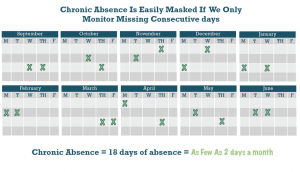Teaching Attendance Main Toolkit page
Please note: Please note: This toolkit was created prior to March 2020. We are continuing to make it available because many of the strategies offered remain applicable. Some adaptions may be needed given changing conditions.
Chronic absenteeism (missing just 2 days per month or 18 days over the school year) can be an early warning sign of academic trouble starting as early as kindergarten and preschool. Missing too many days can lead to struggling to read proficiently by the end of third grade and dropping out in high school, research shows. Nearly 8 million students, in every state and at every grade level, missed three or more weeks of school in 2015-2016. Why are so many students missing so much school?
Chronic absence is often overlooked because educators have traditionally only examined truancy (unexcused absences) and average daily attendance (how many students show up every day).
The good news is that when schools and communities work together to provide a comprehensive, tiered system of supports to students and families—that address the reasons for student absences—they can reduce chronic absence.
Teaching Attendance 2.0 is filled with free, ready-to-use resources for everyone who understands that helping students get to school every day enhances the ability of teachers to teach more effectively.
This toolkit was developed in collaboration with Parent Teacher Home Visits. The Stuart Foundation provided generous support.
Watch our Video on the Introduction Page.
